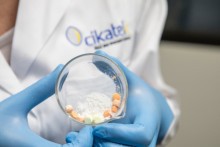Related news by tag Mato Knez
CIC nanoGUNE is participating in two European projects to train young researchers
The social challenge to reduce and prevent the presence of plastics in the seas up for debate

This one-and-a-half day European conference transversally and openly tackled the social challenge to reduce and prevent plastics and microplastics ending up in our oceans. Despite measuring less than 5 mm in all their three dimensions, microplastics include all those minute pieces of plastic that can be easily ingested by ocean inhabitants. More specifically, the three main aims being pursued were as follows: to understand the state of the ocean and the current consequences, to share possible solutions, and to work together to identify problems and barriers that exist with respect to turning the challenge into an achievable reality.
What was unique about the event was that besides gathering together within one and the same space people from across Europe, from Portugal to Greece including Germany and Slovenia, it brought together a group of very different people from the fields of science, technology and industry, as well as political players and the general public. These fields were represented, for example, by the European Commission’s Directorate General for Maritime Affairs and Fisheries (DG MARE), companies such as Nestlé España, Duni and SUEZ, university members (UPV/EHU-University of the Basque Country, University of Salerno (Italy), Leuphana University Lüneburg (Germany), etc.), European research centres and NGOs.
The first question tackled by the group of 17 participants was: What actions are needed to reduce and/or prevent the presence of plastics and microplastics in the ocean? Backed by European Union data on the production of single-use plastic products and “packaging”, the recycling of these materials, the export rate of “rubbish" to less developed countries or incineration, various plausible actions were put forward to encourage the reduction, re-use and recycling of plastic over the next 5 years. So the need to create easily accessible, transparent information was highlighted, and the importance of the circular economy that seeks to encourage the use of plastic debris as a raw material in producing new value plastic products was stressed. What is more, and along these lines, a proposal was made to set up an ecolabel that would inform the consumer in an accurate, straightforward and transparent way about the global impact of the product or packaging.
Events of this type are part of the European Commission’s strategy to transversally tackle the complex challenges facing today’s society so that solutions that are better aligned with the needs and expectations of society as a whole can be built. According to the event coordinators Nagore Ibarra González and Mato Knez of nanoGUNE, “such events help to guarantee more sustainable research and innovation on a human as well as environmental and economic level”. Organizers and participants rated the meeting highly positively, they “expressed great interest in continuing to collaborate in this direction as well as a clear commitment to address this challenge”.
Alternatives to plastic at nanoGUNE
By getting involved in social awareness about finding alternatives to plastic, nanoGUNE has internally committed itself towards a technology that could offer fully biodegradable packaging. As Ainara Garcia-Gallastegui, head of Technology Transfer at nanoGUNE, explained, “we have developed a technology that has the capacity to generate fibrillar structures using sugars or natural proteins, such as milk casein”. These threaded compounds could be produced in the form of films that could be used directly in food packaging and replace plastic packaging completely. Likewise, and given the need to replace single-use plastic packaging, sights are being set on cardboard-based packaging. “Our technology,” explained Garcia-Gallastegui, “may provide a totally biodegradable coating for the cardboard, thus offering the barrier properties needed between the food and the packaging surface”. So “the challenge is to produce completely plastics-free packaging while at the same time keeping its functionality intact”, she added.
The results of this dialogue and the sharing of it will be published shortly at: https://www.nanogune.eu/event/plastics-our-ocean-micro-or-macro-challenge

